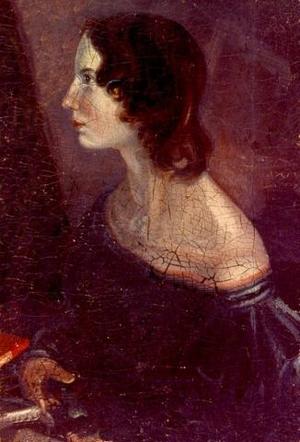“Wuthering Heights” is a gothic novel that is structured around the two parallel love stories of Catherine Earnshaw and Heathcliff and the young Catherine Linton and Hareston Earnshaw. Catherine and Heathcliff share a love so deep that the two souls seem to have intertwined into one. Even after Catherine Earnshaw’s death, she still possesses the twisted heart of Healthcliff while her daughter, young Catherine, must look beyond the prison that holds Hareston capture and see the true man within. The themes of love and death are carefully woven throughout the theme of Bronte’s novel.
Heathcliff, a dark-haired, dark-skinned “gypsy” that Mr. Earnshaw brings home, is the center of conflict in “Wuthering Heights”. Although he has the makings of a romantic hero, Heathcliff is anything but a romantic hero. Traditionally, romantic heroes are dangerous, brooding, and cold in the beginning, but they then to change in the end. Heathcliff, sadly, never changes. His hatred for the Lintons and Earnshaws seems to have grown so deep that it is rooted within his very soul. His abuse of Isabella is sadistic, and his cruelty to young Catherine and Hareston is beyond cruel.
Only Catherine Earnshaw holds Heathcliff’s dark heart. She falls in love with Heathcliff, but sticks with tradition and marries for money. Catherine states,
” I have no more marrying Edgar Linton that I do to be in Heaven; and if that wicked man in there had not brought Heathcliff so low, I shouldn’t have thought of it. It would degrade me to marry Heathcliff now; so he shall never know how much I love him; and not because he is handsome, but because he is more myself than I am” (Bronte, 87).
The Earnshaws and the Lintons are all members of gentry. Heathcliff was not a member of gentry. At the beginning of the novel, he is penniless. It is his lack of money and social status that cause Catherine to decide to marry Edgar instead of Heathcliff.
Despite her marriage to Edgar, Catherine remains madly in love with Heathcliff. She refuses to give up her Heathcliff. It is after a fight between Heathcliff and Edgar that she becomes ill. She eventually dies during childbirth leaving the wrecked Heathcliff to mourn her death. Heathcliff’s love for Catherine is so intense that curses her to haunt him until his death twenty years later:
Catherine Earnshaw, may you not rest as long as I am living! You said that I have killed you-haunt me, then! The murdered do haunt their murders. I believe-I know that ghosts have wandered the earth. Be with me always-take any form-drive me mad! Only do not leave me in this abyss, where I cannot find you! Oh God! It is unutterable1 I cannot live without my life! (Bronte, 176).
Catherine and Heathcliff’s love is so strong that the two have become like one flesh. Catherine declares, “I am Heathcliff.” (Bronte, 88). Upon Catherine’s death, Heathcliff wails that he cannot live without his soul-Catherine. While Catherine at the verge of death, Heathcliff demands that she not abandon him.
Why did you betray your heart, Cathy?…You loved me then what right have you to leave me? What right-answer me-for the poor fancy you felt for Linton? Because misery, and degradation and death, nothing that God or Satan could inflict would have parted us, you, of; your own will did it. I have not broken it, you have broken mine. (Bronte, 170).
Heathcliff continues to love Catherine even after her passing. Eighteen years later, he still cries out with love for her. Heathcliff tells Nelly in chapter twenty-nine that he had bribed the sexton to uncover Catherine’s coffin just so he could see her face again. He is ecstatic that her face is not changed much. He even bribes the sexton to place his body next to Catherine’s after his death.
Even the location of Catherine’s coffin is symbolic of the conflict that ultimately destroys her. She is not buried in the chapel with the Lintons nor is she placed in the tombs of the Earnshaws. Instead, she is buried in the corner of the kirkyard. She is eventually sandwiched between both Edgar and Heathcliff symbolizing the division of her loyalties between the two men.
Catherine’s decision to marry Edgar seems cruel at first, but it is motivated by her love for Heathcliff. She believes that by marrying Edgar she is ensuring Heathcliff’s future. The Lintons have money and social status. These are the things Heathcliff lacks, and Catherine reasons that she will be able to protect Heathcliff through her marriage.
Even after the death of Catherine Earnshaw Linton, the cycle of forbidden love continues with the next generation of Earnshaws and Lintons. The love triangle is repeated and so is the cruel that characterized the first generation.
The second half of the novel moves from the cruel world of adulthood back to the world of innocence found in childhood. The first Catherine’s life ends in grief, but with the emergence of the new generation, one is hopeful that this new set of lovers will come to a happier ending.
Heathcliff, once the poor relation, gains control of the Earnshaw assets and turns Hindley’s son, Hareton, into a younger version of himself. Young Cathy is wild and impulsive like her mother. Linton Heathcliff looks like Edgar, but is just as cruel and manipulative as his father Heathcliff.
Linton Heathcliff wants Young Cathy to love him, but he wants to control her. To him, love is just a means of power. He uses Young Cathy’s love for him to make her obey him. He tricks her into marriage. Once Linton and Young Cathy marry, Linton reveals his true selfish nature. To Linton, as well as his father Heathcliff, marriage means ownership. You Cathy loses everything when she marries the sickly Linton.
The difference in Young Cathy and Hareston’s love story is that instead of being turned into people hardened by their circumstances, they both change for love. At first, Hareston is savage and illiterate, but over time, he becomes a loyal friend to Young Cathy, and he learns to read and write. Young Cathy also undergoes change. Her attitude toward Hareston changes from contempt to love when she realizes that they are both the victims of their parents’ mistakes and of Heathcliff’s revenge.
Young Cathy and Hareston’s relationship is not as intense as that of Catherine Earnshaw and Heathcliff, but it love just the same. Their love tortures Heathcliff. When he sees them, he sees Catherine and himself in their younger years.
In the end, Heathcliff gives up his desire for revenge. It is only when he stops trying to push others for the mistreatment he received as a child that he is able to see his Catherine again. The novel ends with Heathcliff dying and being reunited with his one true love, Catherine Earnshaw.
The threads of never-ending love are woven throughout “Wuthering Heights”. Although twisted, the plot proves that if love is intense and true, “neither death nor life, nor angles nor principalities nor powers, nor thing present nor things to come” can destroy it.
Resources:
Wuthering Heights” by Emily Bronte





